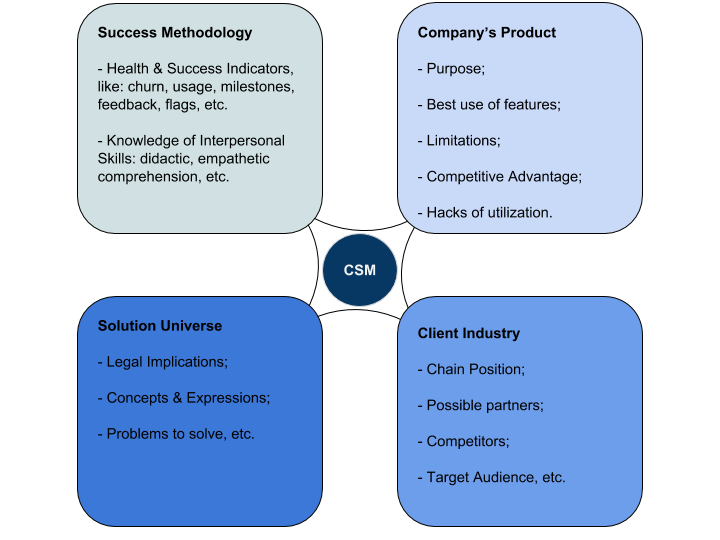
As one of the first Customer Success Managers (CSM) in Brazil, I have faced countless challenges along the way, which I guess qualify me to say one or two things about the kind of expertise a person should develop in order to succeed in our line of work.
Recently, I have decided to frame all this expertise to help companies and professionals plan their training programs.
This post brings what I believe to be the knowledge and skills a Customer Success Manager should master to succeed as a professional. And I will segment the expertise into four groups:
- The culture of managing customer success and its methods;
- The company’s product and how it is correlated to the client’s strategy;
- The universe of the solution that is brought by our product, been a financial solution, a productivity one, a social and so on;
- Then, we’ll talk about understanding your client’s industry to better support them.
You probably have already noticed that these four groups are complementary. Now, let’s dig into them.
Customer Success Management Method
Although just recently acknowledged as an essential practice to retain customers, the customer success management method brings us concepts such as churn, expansion, health score, adoption and habit, just to mention a few, that a professional should master in order to aid the clients and measure their success, while guaranteeing the company’s health.
On the other hand, a group of skills related to the routine of a customer success manager are those associated with a teacher or a consultant such as didactics, persuasion, emotional intelligence, and organization.
I hope it goes without saying that this kind of knowledge is as important to master as the concepts brought by customer success management.
Company’s Product
Customer Success Managers are considered successful when they are able to advocate for the utilization of the product in a client’s strategy.
In other words, whenever we face an opportunity where the client can reach the value proposition of the product, we’ll stand for its correct utilization.
So, there’s no doubt we should know the company’s product in its details, know its limitations, its competitive advantages and possible hacks for utilization.
Without a deep understanding of the company’s product and its usage, the customer success manager becomes a hostage of how clients use it. What happens is that, sometimes, the customer has a bad idea about how to use the product, which will cause him/her to struggle and eventually not to succeed.
That is the time when we can make the difference on our clients’ journey: when we have the opportunity to plan with them how they’ll reach great results, avoiding as much as possible the obstacles along the way!
Solution Universe
Consider now that some customer success managers work for a company that provides solutions for the financial management of a firm.
They will have to understand what management models are used to manage the finances, the laws under which they operate as well as and some more concepts related to it.
If any of those CSM of the group was to move to another company, it would be possible to use all the knowledge and skills learned from customer success management method to deliver success to his/her clients.
For example, if I leave this company and start working for a recruiting software provider, as a customer success manager I’ll have to learn many new things about talents acquisition, interviews, and competencies.
With me, I would bring a whole group of customer success management knowledge and skills learned.
Client Industry
At last, to create an empathic relation with the clients, one should know the details of how the client industry operates, know its players, possible partners and competitors.
This knowledge will allow the customer success manager to be more assertive and didactic, and at the same time, to gain the client trust, who in turn will be more committed to the tasks to be planned.
It’s worth saying that every time we try to better understand our client’s moment before making a statement about what we believe they should do – regardless of what we already know about their product or industry – we’re creating an empathic environment that will give rise to more assertive strategies.
We can now frame these four groups as follow:

So, where to start?
I’m not trying to write a playbook here, it would probably have more exceptions than rules.
Rather than that, I’m trying to put together a few pieces of advice about how I led my studies along all these years: worry more about finding your personal routine of study than about defining the order of topics to be approached.
You’ll certainly be pushed to review topics that you’ve already studied before and this is fine. Every time you get in touch with a topic you’ve already studied, you do this with a renovated perspective, and it allows you to better understand your job and the utilization of the product by your clients.
So don’t waste any more time and throw yourself into the vast world of Customer Success Management. There is plenty of content for you to explore.
Have tips for learning? Contact me and I’ll be very pleased to add it to this post.
P.S.: For this text, I tried to bring some thoughts about preparing new Customer Success Managers to their job, going beyond superficial statements like how developing competencies as emotional intelligence and resilience would be good… The fact is that Customer Success Management methods are still being structured, and it is curious to note that people with so different competencies and soft skills have something to add to this construction.
Based on that perspective, the text focuses the knowledge to be acquired and trained. Hope you find it helpful!